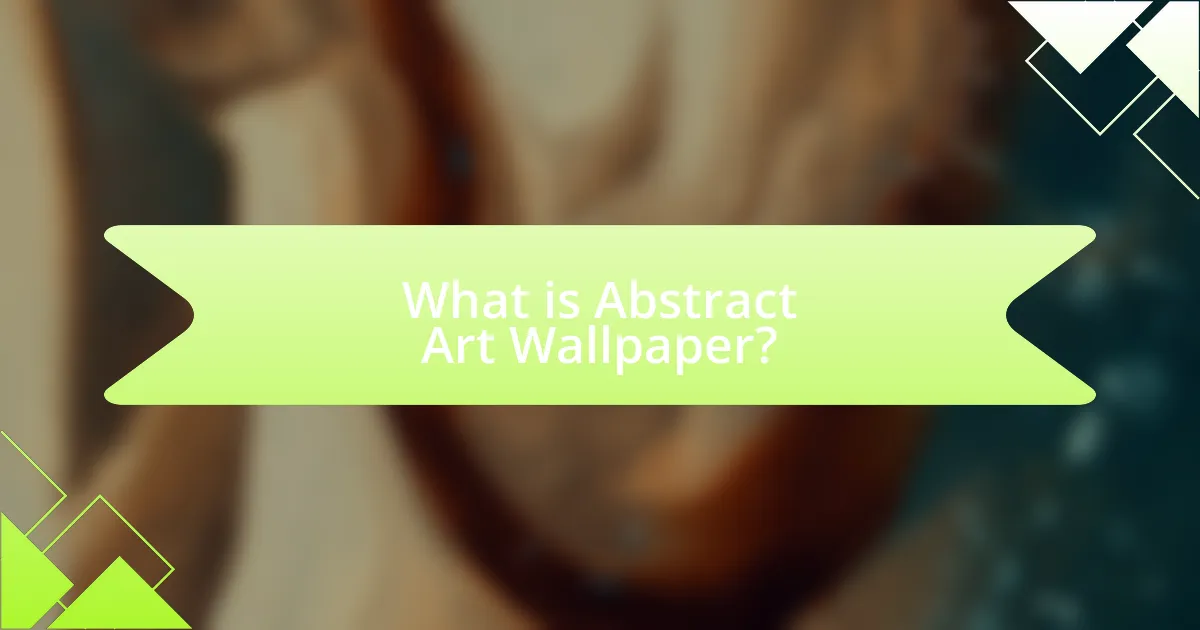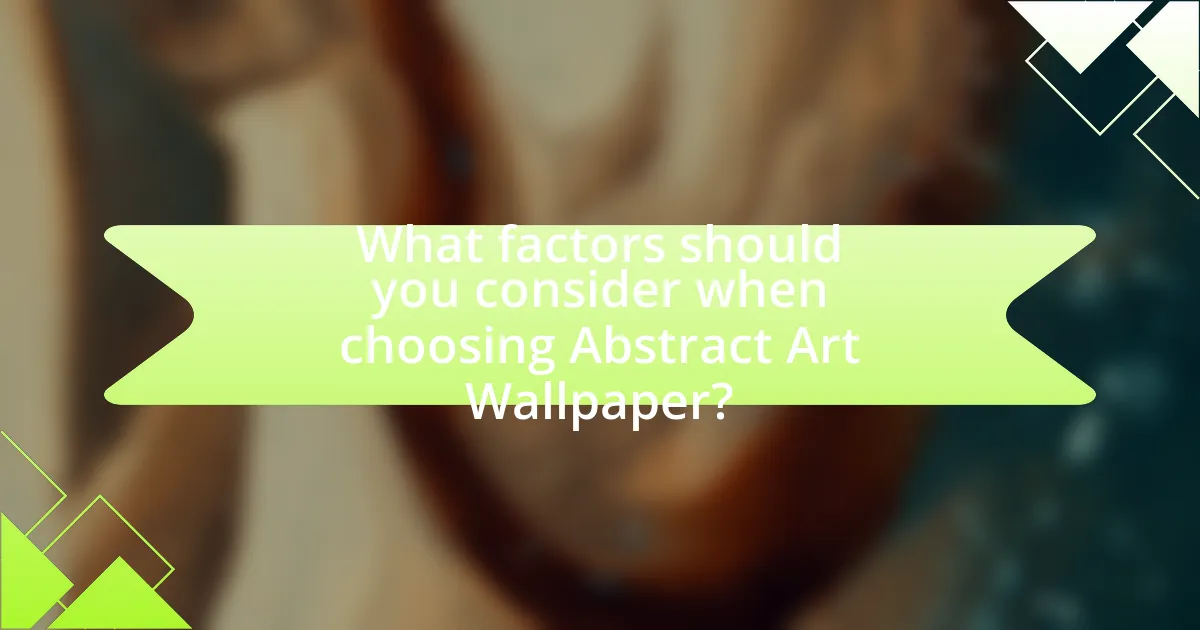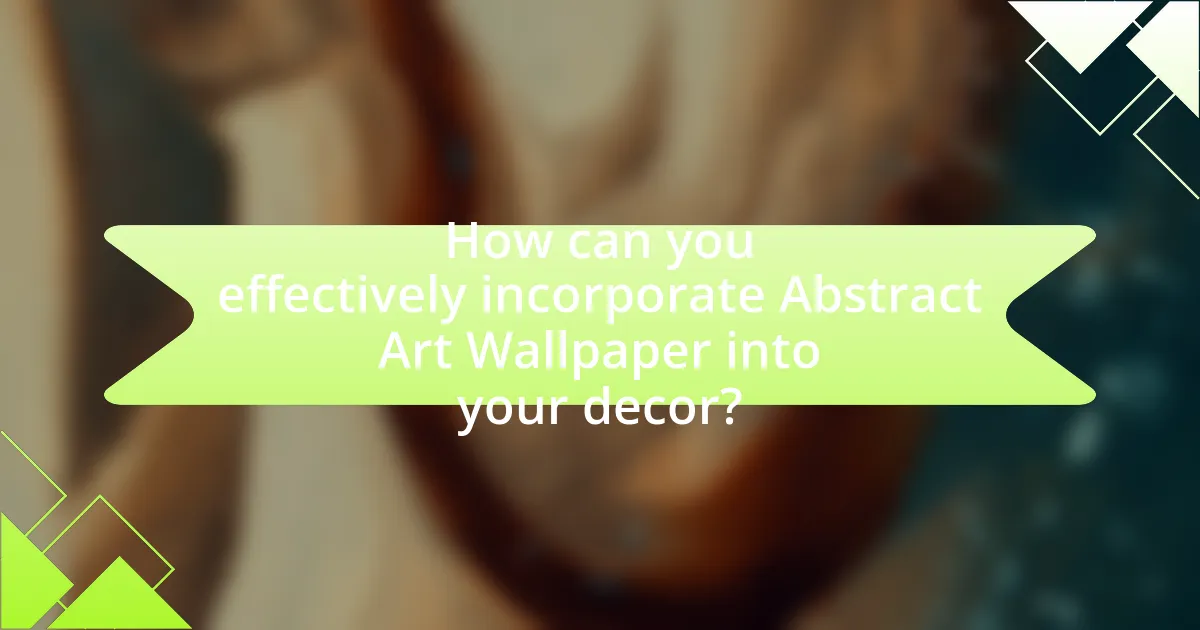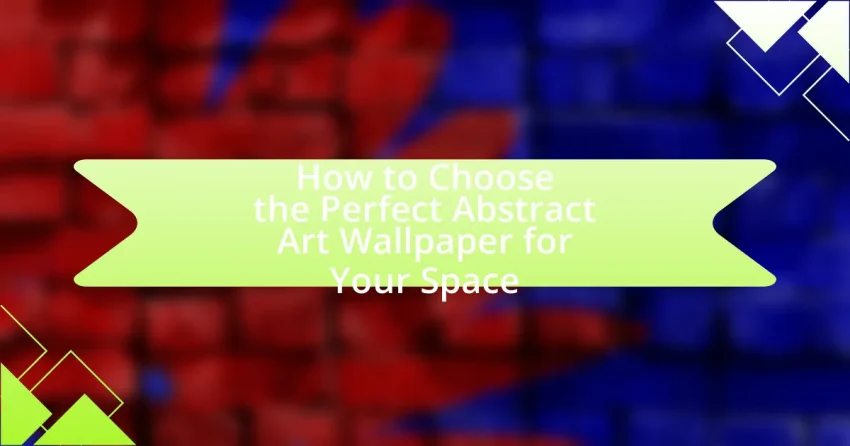Abstract art wallpaper is a decorative wall covering characterized by non-representational forms, colors, and shapes, emphasizing artistic expression over realistic imagery. This article explores the defining characteristics of abstract art, its influence on wallpaper design, and the aesthetic benefits it provides, such as enhancing mood and creativity in various spaces. Key considerations for selecting abstract art wallpaper include color schemes, room size, and existing decor styles, along with maintenance tips to preserve its integrity. The article also highlights the best rooms for this type of wallpaper and common mistakes to avoid during selection, ensuring a successful integration into modern interior design.

What is Abstract Art Wallpaper?
Abstract art wallpaper is a decorative wall covering that features designs characterized by non-representational forms, colors, and shapes. This type of wallpaper often emphasizes artistic expression over realistic depiction, allowing for a wide range of interpretations and emotional responses. Abstract art wallpaper can transform a space by adding depth, vibrancy, and a contemporary aesthetic, making it a popular choice in modern interior design.
How does Abstract Art Wallpaper differ from other types of wallpaper?
Abstract Art Wallpaper differs from other types of wallpaper primarily in its focus on non-representational forms and colors, emphasizing artistic expression rather than realistic imagery. Unlike traditional wallpaper that often features patterns or scenes, Abstract Art Wallpaper utilizes shapes, colors, and textures to evoke emotions and create a unique atmosphere in a space. This artistic approach allows for greater creativity and personalization in interior design, making it suitable for modern and contemporary settings.
What are the defining characteristics of abstract art?
Abstract art is characterized by its use of shapes, colors, forms, and gestural marks to achieve its effect rather than depicting objects or scenes from the real world. This art form emphasizes the expression of emotions and ideas over representational accuracy, allowing for a wide range of interpretations. Notably, abstract art emerged in the early 20th century, with artists like Wassily Kandinsky and Piet Mondrian pioneering its principles, which focus on the intrinsic qualities of color and form rather than narrative content.
How does the style of abstract art influence wallpaper design?
The style of abstract art significantly influences wallpaper design by introducing bold colors, dynamic shapes, and non-representational forms that create visual interest and emotional impact. Abstract art’s emphasis on expression over realism allows wallpaper designers to experiment with patterns and textures that evoke feelings rather than depict specific objects. For instance, the use of vibrant color palettes and fluid forms in abstract art can lead to wallpapers that energize a space, as seen in collections inspired by artists like Wassily Kandinsky, whose work often features geometric shapes and vivid hues. This influence is evident in contemporary wallpaper trends that prioritize artistic expression, allowing for personalized and unique interior aesthetics.
Why choose Abstract Art Wallpaper for your space?
Abstract Art Wallpaper enhances your space by adding a unique aesthetic that stimulates creativity and personal expression. This type of wallpaper often features bold colors and dynamic shapes, making it a focal point that can transform a room’s atmosphere. Studies show that environments with art can improve mood and productivity, supporting the idea that abstract designs can positively influence emotional well-being. Furthermore, abstract art is versatile, complementing various interior styles, from modern to eclectic, thus allowing for personalized decor that reflects individual taste.
What aesthetic benefits does abstract art wallpaper provide?
Abstract art wallpaper enhances aesthetic appeal by introducing vibrant colors, dynamic patterns, and unique designs that can transform a space. This type of wallpaper serves as a focal point, drawing attention and creating visual interest in a room. Additionally, abstract art can evoke emotions and stimulate creativity, making environments feel more engaging and inspiring. Studies in color psychology indicate that certain colors can influence mood and perception, further validating the impact of abstract art wallpaper on the overall ambiance of a space.
How can abstract art wallpaper enhance the mood of a room?
Abstract art wallpaper can enhance the mood of a room by introducing vibrant colors and dynamic patterns that stimulate emotional responses. The use of bold and expressive designs can create an energizing atmosphere, while softer, more subdued abstract patterns can promote relaxation and tranquility. Research indicates that color psychology plays a significant role in influencing mood; for example, warm colors like red and orange can evoke feelings of excitement, while cool colors like blue and green can foster calmness. Therefore, selecting abstract art wallpaper that aligns with the desired emotional tone of the space can effectively transform the overall ambiance.

What factors should you consider when choosing Abstract Art Wallpaper?
When choosing Abstract Art Wallpaper, consider the color scheme, the size of the space, the style of existing decor, and the intended mood. The color scheme should complement or contrast effectively with the room’s palette to create visual harmony. The size of the space influences the scale of the artwork; larger patterns can overwhelm small rooms, while smaller designs may get lost in larger areas. The style of existing decor should align with the abstract art to ensure cohesion, whether it be modern, minimalist, or eclectic. Lastly, the intended mood—whether you want to evoke calmness, energy, or creativity—should guide your choice, as different abstract designs can elicit various emotional responses.
How does the size of your space affect your wallpaper choice?
The size of your space significantly influences your wallpaper choice by determining the scale, pattern, and color of the wallpaper that will be most effective. In smaller spaces, lighter colors and smaller patterns can create an illusion of openness, making the area feel larger, while larger patterns and darker colors can overwhelm and make the space feel cramped. Conversely, in larger spaces, bold patterns and darker colors can add depth and character, preventing the area from feeling too empty or sterile. Research indicates that color psychology plays a role in how individuals perceive space; for instance, light colors tend to reflect more light, enhancing the perception of space, while dark colors absorb light, which can make a room feel cozier but smaller.
What patterns work best in small versus large rooms?
In small rooms, patterns that are subtle and less busy, such as small-scale geometric designs or light, airy motifs, work best to avoid overwhelming the space. These patterns create an illusion of openness and can make the room feel larger. In contrast, large rooms benefit from bold, larger-scale patterns that can fill the space effectively and create a focal point. For example, oversized florals or dramatic abstract designs can enhance the grandeur of a large room without making it feel empty. This distinction is supported by interior design principles that emphasize scale and proportion in relation to room size.
How can scale impact the perception of space?
Scale significantly impacts the perception of space by influencing how individuals interpret dimensions and distances within an environment. Larger scale elements can create a sense of openness and grandeur, making a space feel more expansive, while smaller scale elements can evoke intimacy and coziness. For instance, a large abstract art wallpaper can dominate a room, drawing attention and creating a focal point that enhances the perception of height and width, thereby altering the viewer’s experience of the space. Conversely, smaller artworks may blend into the background, making the area feel more confined. Research in environmental psychology indicates that scale affects emotional responses and spatial awareness, demonstrating that the size of objects can manipulate how we perceive and interact with our surroundings.
What color schemes should you consider for your wallpaper?
Consider complementary, analogous, and monochromatic color schemes for your wallpaper. Complementary schemes involve colors opposite each other on the color wheel, creating vibrant contrasts that can energize a space. Analogous schemes use colors next to each other on the wheel, providing harmony and a serene atmosphere. Monochromatic schemes focus on variations of a single color, offering a sophisticated and cohesive look. These color schemes are effective in enhancing the aesthetic appeal of abstract art wallpaper, as they can either highlight the artwork or create a balanced backdrop.
How do colors influence the ambiance of a room?
Colors significantly influence the ambiance of a room by affecting mood and perception. For instance, warm colors like red and orange can create a sense of energy and warmth, while cool colors such as blue and green tend to evoke calmness and tranquility. Research indicates that color psychology plays a crucial role in how individuals respond emotionally to their environment; for example, a study published in the journal “Color Research and Application” found that colors can impact feelings of comfort and satisfaction in a space. Thus, selecting the right colors can enhance the overall atmosphere and functionality of a room.
What are the best color combinations for abstract art wallpaper?
The best color combinations for abstract art wallpaper include blue and gold, which create a striking contrast and evoke a sense of calmness and luxury. Additionally, black and white combinations offer a timeless and sophisticated look, enhancing the visual impact of the artwork. Another effective pairing is teal and coral, which provides a vibrant and energetic feel, making spaces more inviting. Research indicates that color psychology plays a significant role in how colors affect mood and perception, supporting the effectiveness of these combinations in creating desired atmospheres in interior spaces.

How can you effectively incorporate Abstract Art Wallpaper into your decor?
To effectively incorporate Abstract Art Wallpaper into your decor, select a focal wall to apply the wallpaper, ensuring it complements existing color schemes and furniture. This approach draws attention to the artwork while maintaining harmony in the space. For instance, using a bold abstract design on a single wall can create a striking visual impact without overwhelming the room. Additionally, pairing the wallpaper with minimalist decor allows the art to stand out, as supported by interior design principles that emphasize balance and contrast.
What are the best rooms for Abstract Art Wallpaper?
The best rooms for Abstract Art Wallpaper are living rooms, bedrooms, and home offices. Living rooms benefit from abstract art wallpaper as it creates a focal point and stimulates conversation, enhancing the overall ambiance. Bedrooms can use abstract designs to evoke a sense of tranquility and personal expression, contributing to a relaxing atmosphere. Home offices gain inspiration and creativity from abstract art wallpaper, making the workspace more engaging and visually appealing. These rooms are ideal because they allow for personal expression and can significantly influence mood and functionality.
How does the function of a room influence wallpaper selection?
The function of a room significantly influences wallpaper selection by determining the desired atmosphere and durability requirements. For instance, a living room, which serves as a social space, may benefit from vibrant and inviting wallpaper designs that promote interaction, while a bedroom, intended for relaxation, might call for softer, calming patterns. Additionally, high-traffic areas like hallways require wallpapers that are more durable and easy to clean, often leading to the selection of vinyl or washable materials. This alignment between room function and wallpaper choice ensures that the aesthetic complements the practical needs of the space.
What styles of decor pair well with abstract art wallpaper?
Abstract art wallpaper pairs well with modern, minimalist, and eclectic decor styles. Modern decor emphasizes clean lines and simplicity, allowing the bold colors and shapes of abstract art to stand out. Minimalist decor, characterized by a “less is more” approach, complements abstract wallpaper by providing a neutral backdrop that enhances the artwork’s visual impact. Eclectic decor, which mixes various styles and textures, allows for creative expression and can harmonize with the dynamic nature of abstract art, creating a vibrant and personalized space.
How do you maintain and care for Abstract Art Wallpaper?
To maintain and care for Abstract Art Wallpaper, regularly dust the surface with a soft, dry cloth to prevent dirt buildup. Additionally, for deeper cleaning, use a damp cloth with mild soap, ensuring not to saturate the wallpaper, as excessive moisture can damage it. It is essential to avoid abrasive cleaners or scrubbing, which can scratch or fade the artwork. Regular inspections for signs of peeling or damage should be conducted, allowing for timely repairs to preserve the wallpaper’s appearance. These practices help maintain the integrity and vibrancy of Abstract Art Wallpaper, ensuring it remains a focal point in your space.
What cleaning methods are safe for different wallpaper materials?
Cleaning methods vary based on wallpaper materials, and specific techniques ensure safety and effectiveness. For vinyl wallpaper, a damp cloth with mild soap is safe, as vinyl is water-resistant and durable. For fabric wallpaper, a dry cleaning sponge or a vacuum with a brush attachment is recommended to avoid water damage. Paper wallpaper requires a gentle approach; using a soft, dry cloth or a specialized wallpaper cleaner is best to prevent tearing or discoloration. Textured wallpaper can be cleaned with a soft brush to remove dust without damaging the surface. These methods are validated by industry guidelines, which emphasize the importance of using appropriate cleaning techniques to maintain the integrity of different wallpaper types.
How can you prevent damage to your wallpaper over time?
To prevent damage to your wallpaper over time, regularly clean it with a soft, damp cloth and avoid using harsh chemicals. This maintenance helps remove dust and stains without compromising the wallpaper’s integrity. Additionally, using UV-protective window treatments can minimize fading caused by sunlight exposure, which is a common issue for wallpapers. According to the Wallpaper Association, proper care can extend the lifespan of wallpaper by several years, emphasizing the importance of routine maintenance and environmental control.
What are some tips for choosing the perfect Abstract Art Wallpaper?
To choose the perfect abstract art wallpaper, consider the color scheme of your space, ensuring the wallpaper complements or contrasts effectively with existing decor. Selecting a design that resonates with your personal style is crucial, as it will influence the overall ambiance of the room. Additionally, assess the scale of the artwork; larger patterns can create a bold statement in spacious areas, while smaller designs may suit more intimate settings. Finally, consider the texture and material of the wallpaper, as these factors can enhance the visual interest and tactile experience of the space.
How can you test wallpaper samples before making a decision?
To test wallpaper samples before making a decision, obtain physical samples of the wallpaper and apply them to your wall. This allows you to assess the color, texture, and pattern in the actual lighting and space where it will be installed. Additionally, consider using removable wallpaper or adhesive to temporarily place the samples, enabling you to visualize how they complement your decor and furniture. This method provides a realistic preview, ensuring the chosen wallpaper aligns with your aesthetic preferences and the overall ambiance of the room.
What common mistakes should you avoid when selecting wallpaper?
When selecting wallpaper, avoid common mistakes such as neglecting to consider the room’s lighting, which can significantly alter the appearance of colors and patterns. Additionally, failing to measure wall dimensions accurately can lead to purchasing insufficient or excessive material, resulting in wasted resources. Choosing a design that does not complement existing decor can create a disjointed aesthetic, while overlooking the wallpaper’s durability and washability may lead to maintenance issues over time. Lastly, ignoring the scale of patterns in relation to room size can make a space feel cramped or overwhelming. These mistakes can detract from the overall impact of the wallpaper and the intended ambiance of the space.
